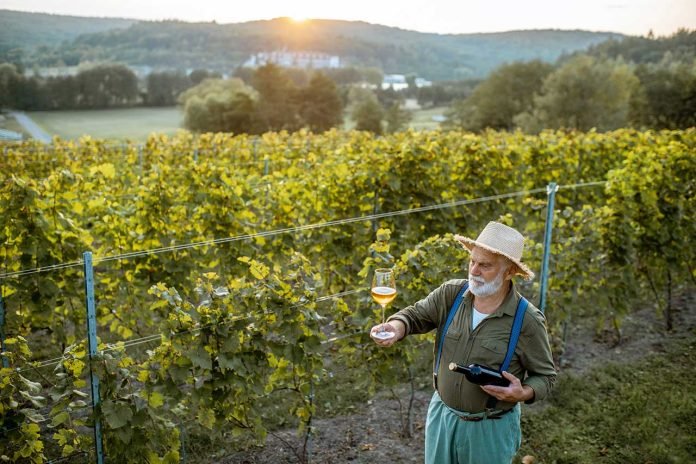French wine and vineyards vary greatly depending on the region. Each region offers its distinct character, steeped in tradition and flavored with history, each vineyard has a story to tell often stretching back many hundreds of years. Whether you’re a seasoned oenophile or a novice, a wine journey through France’s picturesque vineyards is a sensory feast that you must experience.
Bordeaux: The Birthplace of Full-bodied Reds
Nestled in the southwest of France along the Atlantic Coast, Bordeaux is one of the most distinguished wine regions in the world. Its vineyards stretch over 120,000 hectares, making it the largest wine-growing area in France.
Bordeaux’s viticultural roots date back to the Romans, who first planted vineyards here around 60 BC. Over centuries, the region flourished, especially during the 12th century when the marriage of Henry Plantagenet and Eleanor of Aquitaine opened the British market to Bordeaux wines.
Bordeaux is best known for its full-bodied reds, predominantly blended from Cabernet Sauvignon, Merlot, and Cabernet Franc. However, the region also produces excellent dry and sweet white wines, mainly from Sémillon, Sauvignon Blanc, and Muscadelle.
Burgundy: The Abode of Elegant Pinot Noirs
Burgundy, or Bourgogne, situated in eastern France, offers a wine journey unlike any other, replete with an impressive tapestry of terroirs.
Much like Bordeaux, Burgundy’s wine history is extensive, tracing back to Roman times. However, it was the Benedictine and Cistercian monks in the Middle Ages who meticulously identified the individual plots of land or “climats” that could produce distinct, exceptional wines.
Burgundy is most famous for its Pinot Noir and Chardonnay, with the region split into the Côte de Nuits (famed for Pinot Noir) and the Côte de Beaune (known for its splendid Chardonnay). Its wines are often described as the purest expressions of these grapes, with an emphasis on terroir over blending.
Champagne: The Sparkling Star of France
Champagne, the northernmost wine region of France, is celebrated worldwide for its eponymous sparkling wine.
While viticulture in Champagne dates back to Roman times, the sparkling wine we know today did not become the region’s signature until the 17th century. This is largely thanks to the contributions of Dom Pérignon, a Benedictine monk who worked tirelessly to improve the quality and reputation of Champagne’s wines.
Champagne is unique for its méthode champenoise, a process where the wine undergoes a secondary fermentation in the bottle to create those delicate bubbles. The region’s wines are typically made from a blend of Chardonnay, Pinot Noir, and Pinot Meunier, and they range from sweet (doux) to dry (brut).
Loire Valley: The Garden of France
The Loire Valley, with its stunning castles and lush vineyards, is a wine lover’s paradise.
The Loire Valley’s winemaking history goes back more than 2,000 years, yet it was only in the Middle Ages and Renaissance periods that the region became especially renowned, recognized by kings and nobility for its exceptional wines.
The Loire Valley is famous for its diverse range of wines. It’s known for superb whites from Chenin Blanc and Sauvignon Blanc, light-bodied reds from Cabernet Franc (Chinon, Bourgueil), as well as crisp, delightful rosés and even sparkling wines (Crémant de Loire).
Alsace: A Blend of Franco-Germanic Charm
Situated in northeastern France, along the Rhine River, Alsace presents a fascinating mix of French and German influences, reflected in its unique wines.
Alsace‘s viticulture dates back to Roman times, but its turbulent history, with control oscillating between Germany and France, has greatly influenced its wine style and culture.
Primarily a white wine region, Alsace’s distinctive wines, bottled in German-style fluted glasses, include Riesling, Gewurztraminer, Pinot Blanc, and Pinot Gris. The region is also renowned for its Crémant d’Alsace, a sparkling wine produced in the traditional method.
Rhône Valley: The Sun-drenched Vineyards
The Rhône Valley, stretching from Lyon to Avignon, is divided into North and South, each with its unique climatic conditions and varietals.
The Greeks introduced viticulture to the Rhône Valley around 600 BC, and the region’s reputation grew under Roman influence, with its wines becoming a favored choice across the empire.
Northern Rhône produces powerful, aromatic red wines from the Syrah grape (think Côte-Rôtie and Hermitage), and exquisite whites from Viognier, Marsanne, and Roussanne. In contrast, the South, with its warmer climate, is known for its blends, with Grenache playing a dominant role in renowned appellations like Châteauneuf-du-Pape.
Provence: The Rosé Capital
Located in southeastern France, adjacent to the Mediterranean, Provence, with its lavender fields and sun-drenched vineyards, is truly a sight to behold.
Provence is the oldest wine-producing region in France, with the Greeks having planted the first vines around 600 BC. The Romans further expanded viticulture upon their arrival.
Provence is universally celebrated for its rosé wines, which account for nearly 90% of its production. Typically dry and crisp, these rosés are primarily made from Grenache, Syrah, and Cinsault. However, the region also produces respected reds and whites in lesser quantities.
Each of these regions is a chapter in France’s rich wine anthology, waiting to be discovered, tasted, and savored. Immerse yourself in their stories and allow their wines to captivate your senses, leaving an indelible mark on your wine-loving soul. France’s vineyards invite you to a grand spectacle of taste, history, and breathtaking landscapes, an experience that transcends the ordinary.
Beaujolais: The Land of Vibrant Reds
To the south of Burgundy lies Beaujolais, a region celebrated for its vivacious and fruity red wines.
The roots of Beaujolais’ viticulture stretch back to Roman times, with commercial wine production beginning in the 17th century. The region truly came into the limelight with the inception of Beaujolais Nouveau in the 20th century – a wine released just weeks after harvest.
Beaujolais is synonymous with the Gamay grape, which gives birth to wines ranging from light and fruity Beaujolais Nouveau to more complex and structured offerings from the ten ‘crus’ of Beaujolais, such as Moulin-à-Vent and Fleurie.
Languedoc-Roussillon: A Tapestry of Terroirs
Languedoc-Roussillon, the largest wine-producing region in France, lies along the Mediterranean coast. It’s a diverse and dynamic region that’s been undergoing a quality revolution.
Though the Greeks planted the first vines, it was during the Roman era that wine production exploded. The region, however, was long known for its bulk wines until the late 20th century, when a focus shift to quality led to a significant resurgence.
The region is known for its wide range of wine styles – from robust, spicy reds (Syrah, Grenache, Carignan, Mourvèdre) and aromatic whites (Picpoul, Roussanne, Marsanne) to world-class rosés and even sparkling Crémant de Limoux.
Jura: A Hidden Gem
Tucked between Burgundy and Switzerland, Jura may be one of the smallest wine regions in France, but it holds a treasure trove of unique wines.
Dating back to the 1st century AD, winemaking in Jura has a long-standing history. Yet, its relative isolation preserved its distinctive wine style, even as it remained a well-kept secret.
Jura’s wines are as unique as their region of origin. These include nutty, sherry-like ‘Vin Jaune’, made from the indigenous Savagnin grape, and delightful reds from Poulsard and Trousseau. Chardonnay also thrives here and is often made in an oxidative style.
Corsica: The Wine Island
Located in the Mediterranean Sea, the island of Corsica offers a blend of French and Italian viticulture, surrounded by the beautiful sea.
Wine has been produced on Corsica since the Phocaean Greeks settled here in 570 BC. Despite the various political controls – Genoese, French, and briefly British – Corsican viticulture has retained its individuality.
Corsican wines are predominantly made from indigenous grape varieties. Nielluccio and Sciaccarellu lead the way for reds and rosés, creating wines that combine French finesse with Italian vitality. Vermentino, locally known as ‘Rolle’, is the key white variety, creating fresh, aromatic wines.
Each of these regions is yet another fascinating page in France’s viticultural storybook. While smaller or less known than their famous siblings, they offer some of the most compelling and unique wines, presenting both the classic and the unconventional, the expected and the surprising. These are the French vineyards that continue to break boundaries and invite the adventurous wine explorer to a journey of delightful discoveries.



